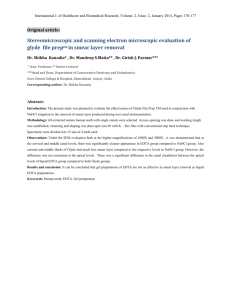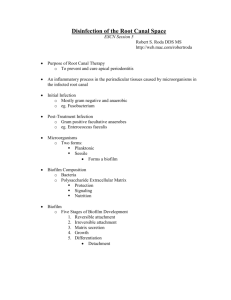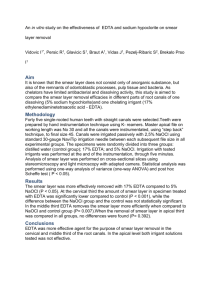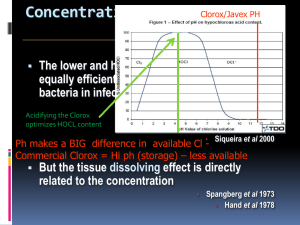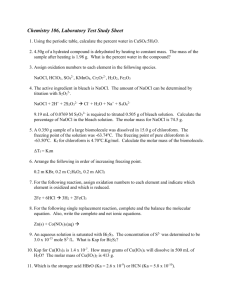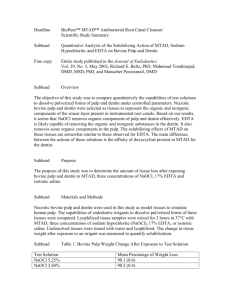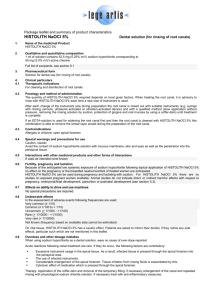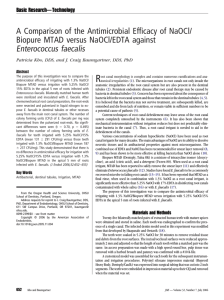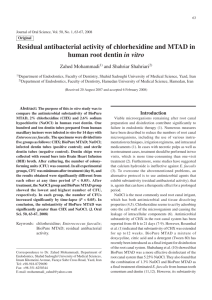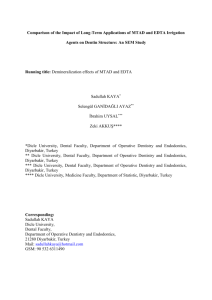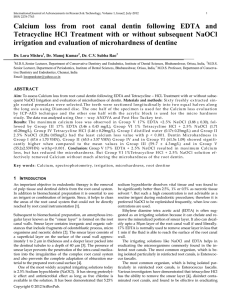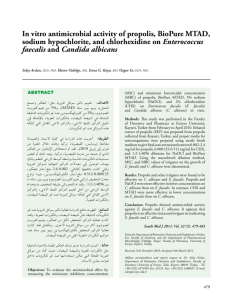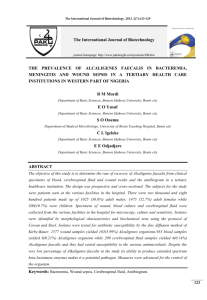The Antimicrobial Effect of MTAD: An In Vitro
advertisement
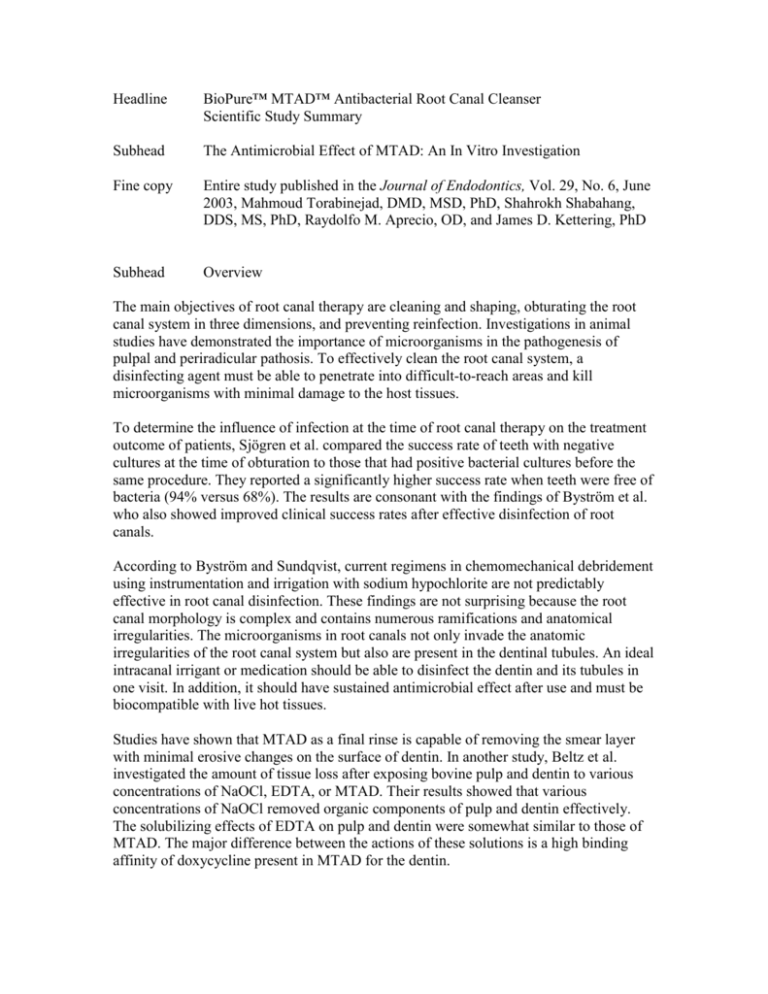
Headline BioPure™ MTAD™ Antibacterial Root Canal Cleanser Scientific Study Summary Subhead The Antimicrobial Effect of MTAD: An In Vitro Investigation Fine copy Entire study published in the Journal of Endodontics, Vol. 29, No. 6, June 2003, Mahmoud Torabinejad, DMD, MSD, PhD, Shahrokh Shabahang, DDS, MS, PhD, Raydolfo M. Aprecio, OD, and James D. Kettering, PhD Subhead Overview The main objectives of root canal therapy are cleaning and shaping, obturating the root canal system in three dimensions, and preventing reinfection. Investigations in animal studies have demonstrated the importance of microorganisms in the pathogenesis of pulpal and periradicular pathosis. To effectively clean the root canal system, a disinfecting agent must be able to penetrate into difficult-to-reach areas and kill microorganisms with minimal damage to the host tissues. To determine the influence of infection at the time of root canal therapy on the treatment outcome of patients, Sjögren et al. compared the success rate of teeth with negative cultures at the time of obturation to those that had positive bacterial cultures before the same procedure. They reported a significantly higher success rate when teeth were free of bacteria (94% versus 68%). The results are consonant with the findings of Byström et al. who also showed improved clinical success rates after effective disinfection of root canals. According to Byström and Sundqvist, current regimens in chemomechanical debridement using instrumentation and irrigation with sodium hypochlorite are not predictably effective in root canal disinfection. These findings are not surprising because the root canal morphology is complex and contains numerous ramifications and anatomical irregularities. The microorganisms in root canals not only invade the anatomic irregularities of the root canal system but also are present in the dentinal tubules. An ideal intracanal irrigant or medication should be able to disinfect the dentin and its tubules in one visit. In addition, it should have sustained antimicrobial effect after use and must be biocompatible with live hot tissues. Studies have shown that MTAD as a final rinse is capable of removing the smear layer with minimal erosive changes on the surface of dentin. In another study, Beltz et al. investigated the amount of tissue loss after exposing bovine pulp and dentin to various concentrations of NaOCl, EDTA, or MTAD. Their results showed that various concentrations of NaOCl removed organic components of pulp and dentin effectively. The solubilizing effects of EDTA on pulp and dentin were somewhat similar to those of MTAD. The major difference between the actions of these solutions is a high binding affinity of doxycycline present in MTAD for the dentin. Subhead Purpose The purpose of this investigation was to test the ability of a mixture of a tetracycline isomer, an acid, and a detergent (MTAD) to kill Enterococcus faecalis and compare its efficacy to that of sodium hypochlorite (NaOCl) and ethylene diamine tetraacetic acid (EDTA). The zones of inhibition and minimum inhibitory concentrations were measured for these solutions. E. faecalis was selected because this bacterium has been identified as one of the most difficult bacterial species to eradicate from infected root canals. The persistence of E. faecalis may be attributed to the ineffectiveness of currently used chemicals such as sodium hypochlorite, potassium iodide, or calcium hydroxide. Subhead Materials and Methods Two methods were used to determine the extent of antimicrobial activity of MTAD and to compare it with those of NaOCl and EDTA. The ability of MTAD to kill E. faecalis was evaluated in an in vitro model without the presence of the variables that are encountered in a tooth model. Standard microbiological methods were used to determine the antimicrobial properties of MTAD in comparison to NaOCl and EDTA. Determination of the zones of inhibition provided quantitative data, which allowed statistical analysis. A disadvantage of determining the antimicrobial effect of a solution by measuring the zone of inhibition is that this technique does not account for the variation in the diffusion rate of the medication through the agar. To address this concern, a second technique was used to verify the results of the first experiment. The minimum inhibitory concentration (MIC) method uses serial dilutions of a solution to determine the minimum concentration that would still exert antimicrobial properties. In this experiment, the MIC method confirmed that EDTA possesses little or no bactericidal activity. Although dilution reduced the zone of inhibition for all irrigants tested, the results of both microbiological methods demonstrated that MTAD maintains its bactericidal properties significantly more than NaOCl or EDTA. Subhead Conclusion Although EDTA demonstrated no antibacterial effects against E. faecalis, NaOCl and MTAD proved to be antibacterial to varying degrees. NaOCl continued to exert its efficacy up to 32x dilutions. On the other hand, MTAD was effective in killing E. faecalis up to 200x dilutions. Furthermore, although a 2- and 5-minute exposure of E. faecalis to undiluted or 1:2 dilution of NaOCl did not result in total killing of the bacteria, exposure of the same bacterial species to undiluted or 1:2 diluted MTAD resulted in a completely negative culture after 2 or 5 minutes of exposure. Based on the results of this and previous investigations, it seems that MTAD has the ability to remove most of the smear layer and it possesses superior bactericidal activity compared with NaOCl or EDTA when tested against E. faecalis. These results are significant because they demonstrate the efficacy of an irrigant to remove most of the smear layer and kill a bacterial strain that has been shown to be resistant to many commonly used intracanal irrigants and dressings.
